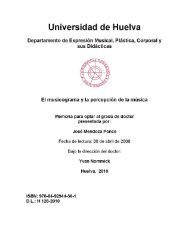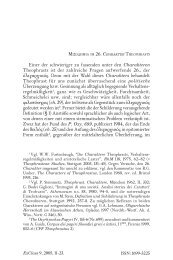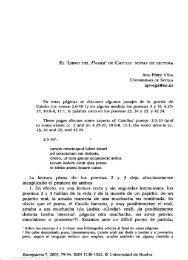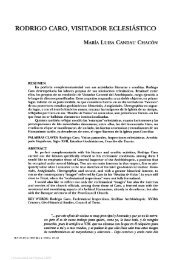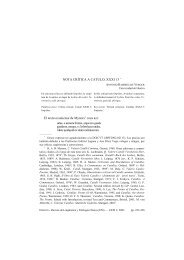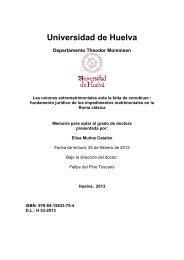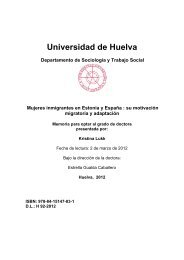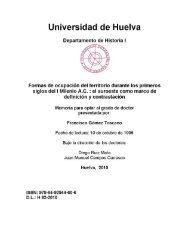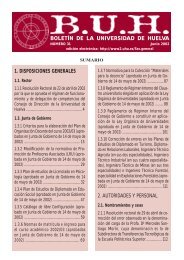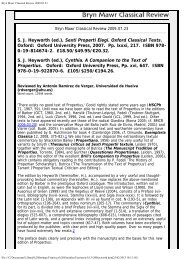- Page 1 and 2:
Universidad de Huelva Departamento
- Page 3 and 4:
Mis más sinceros agradecimientos a
- Page 5 and 6:
ÍNDICE DE FIGURAS MARCO TEÓRICO C
- Page 7 and 8:
- FIGURA 36: Media de recuerdo de l
- Page 9 and 10:
CAPÍTULO 7: ANÁLISIS COMPARATIVO
- Page 11 and 12:
Introducción Durante muchos años,
- Page 13 and 14:
Introducción aumentándolo las muj
- Page 15 and 16:
MARCO TEÓRICO
- Page 17 and 18:
1. INTRODUCCIÓN Marco Teórico El
- Page 19 and 20:
Marco Teórico etapas 6 ó 7 en cas
- Page 21 and 22:
Marco Teórico el ámbito de las ad
- Page 23 and 24:
Marco Teórico 4. La mayoría de la
- Page 25 and 26:
Marco Teórico ubicación previamen
- Page 27 and 28:
Marco Teórico 2.4. Preparación: f
- Page 29 and 30:
Marco Teórico de riesgo podrían s
- Page 31 and 32:
Marco Teórico 2.1.4. Acción: es l
- Page 33 and 34:
Marco Teórico directos e indirecto
- Page 35 and 36:
Marco Teórico Los procesos han sid
- Page 37 and 38:
Marco Teórico 2.4. Balance decisio
- Page 39 and 40:
2.6. Tentaciones situacionales Marc
- Page 41 and 42:
Marco Teórico reducir en gran medi
- Page 43 and 44:
Marco Teórico fiabilidad de este c
- Page 45 and 46:
Marco Teórico consecutivos sobre u
- Page 47 and 48:
Marco Teórico que los individuos q
- Page 49 and 50:
Marco Teórico Sistema Experto con
- Page 51 and 52:
Marco Teórico en precontemplación
- Page 53 and 54:
Marco Teórico coherente (p.ej.: ti
- Page 55 and 56:
Marco Teórico predictivo de estas
- Page 57 and 58:
• la carencia de validez de los a
- Page 59 and 60:
Marco Teórico etapas, y han utiliz
- Page 61 and 62:
Marco teórico En el capítulo ante
- Page 63 and 64:
Marco teórico En referencia a los
- Page 65 and 66:
Marco teórico este modo, las perso
- Page 67 and 68:
Marco teórico sobre el sistema emo
- Page 69 and 70:
Marco teórico también intervendr
- Page 71 and 72:
3. TEORÍAS DE LA ADICCIÓN Marco t
- Page 73 and 74:
Marco teórico mesolímbica. Para e
- Page 75 and 76:
Marco teórico estímulos relaciona
- Page 77 and 78:
Marco teórico por consumir la sust
- Page 79 and 80:
Marco teórico el resultado de los
- Page 81 and 82:
4. PARADIGMAS EXPERIMENTALES DE LOS
- Page 83 and 84:
Marco teórico Una vez definida la
- Page 85 and 86:
Marco teórico b. Tiene validez con
- Page 87 and 88:
Marco teórico incongruentes están
- Page 89 and 90:
Marco teórico dificultad de la tar
- Page 91 and 92:
Marco teórico mantienen que los es
- Page 93 and 94:
Marco teórico negativamente a esta
- Page 95 and 96:
Marco teórico que favorecen el acc
- Page 97 and 98:
Marco teórico varias personas most
- Page 99 and 100:
Marco teórico esfuerzo mental y es
- Page 101 and 102:
Marco teórico estados afectivos ac
- Page 103 and 104:
Marco teórico En pocos estudios no
- Page 105 and 106:
Marco teórico Hasta aquí hemos co
- Page 107 and 108:
Marco teórico Rusted et al. (2000)
- Page 109 and 110:
Marco teórico Los resultados de es
- Page 111 and 112:
Marco teórico automóviles y cigar
- Page 113 and 114:
Marco teórico autorreferido) no pu
- Page 115 and 116:
OBJETIVOS
- Page 117 and 118:
1. OBJETIVO GENERAL Objetivos Evalu
- Page 119 and 120:
CAPÍTULO 4: METODOLOGÍA 1. DISEÑ
- Page 121 and 122:
MTT y sesgos cognitivos Para establ
- Page 123 and 124:
MTT y sesgos cognitivos No fumadore
- Page 125 and 126:
MTT y sesgos cognitivos No existen
- Page 127 and 128:
MTT y sesgos cognitivos Tabla 4: Cl
- Page 129 and 130:
MTT y sesgos cognitivos 124 • Acc
- Page 131 and 132:
MTT y sesgos cognitivos 3.3.5. Háb
- Page 133 and 134:
MTT y sesgos cognitivos • Pregunt
- Page 135 and 136:
MTT y sesgos cognitivos 130 4.4.1.
- Page 137 and 138:
MTT y sesgos cognitivos 4.6. Invent
- Page 139 and 140:
MTT y sesgos cognitivos enfermedad;
- Page 141 and 142:
MTT y sesgos cognitivos presentaci
- Page 143 and 144:
MTT y sesgos cognitivos Tabla 5: Pa
- Page 145 and 146:
MTT y sesgos cognitivos Se emplearo
- Page 147 and 148:
MTT y sesgos cognitivos ítem que s
- Page 149 and 150:
RESULTADOS
- Page 151 and 152:
Resultados Antes de iniciar la expo
- Page 153 and 154:
2.2.Hábitos de salud Resultados En
- Page 155 and 156:
2.5. Preocupación sobre la salud R
- Page 157 and 158:
Resultados Otro resultado significa
- Page 159 and 160: 3.5.Recuerdo Resultados En virtud d
- Page 161 and 162: Resultados 3.6 Reconocimiento Pasar
- Page 163 and 164: Resultados al efecto de los factore
- Page 165 and 166: Resultados El ‘Contenido de palab
- Page 167 and 168: 80 70 60 50 40 30 20 10 0 Tabaco Co
- Page 169 and 170: Resultados 1. DESCRIPCIÓN SOCIODEM
- Page 171 and 172: Resultados 4,66), contemplación: 8
- Page 173 and 174: Resultados que fuma regularmente ci
- Page 175 and 176: 2.2. Tentaciones y autoeficacia Res
- Page 177 and 178: Resultados contempladores se siente
- Page 179 and 180: Resultados En este estudio, ambos t
- Page 181 and 182: Resultados los fumadores se van pla
- Page 183 and 184: Resultados significativas (F(4,139)
- Page 185 and 186: Resultados 3.4. Depresión En relac
- Page 187 and 188: CAPÍTULO 7: ANÁLISIS COMPARATIVO
- Page 189 and 190: MTT y sesgos cognitivos Tabla 14: A
- Page 191 and 192: MTT y sesgos cognitivos 3. FACILITA
- Page 193 and 194: MTT y sesgos cognitivos Tabla 16: R
- Page 195 and 196: MTT y sesgos cognitivos 6. RECONOCI
- Page 197 and 198: MTT y sesgos cognitivos Tabla 19: R
- Page 199 and 200: MTT y sesgos cognitivos También se
- Page 201 and 202: MTT y sesgos cognitivos 80 70 60 50
- Page 203 and 204: Resultados 1. COMPARACIÓN DE LAS E
- Page 205 and 206: Resultados en situaciones de hábit
- Page 207 and 208: Resultados 1.3. Variables del MTT A
- Page 209: Resultados En relación a las tenta
- Page 213 and 214: 1.5. Variables psicológicas en con
- Page 215 and 216: 60 50 40 30 20 10 0 -10 -20 -30 Dia
- Page 217 and 218: Resultados En esta ocasión no se h
- Page 219 and 220: Tabla 27: Resultados del ANOVA del
- Page 221 and 222: Discusión y conclusiones 1. CARACT
- Page 223 and 224: Discusión y conclusiones 1.3. Dist
- Page 225 and 226: Discusión y conclusiones de Navarr
- Page 227 and 228: 2.2. Variables experimentales Discu
- Page 229 and 230: Discusión y conclusiones En cuanto
- Page 231 and 232: Discusión y conclusiones evidencia
- Page 233 and 234: Discusión y conclusiones al compor
- Page 235 and 236: Discusión y conclusiones modo, se
- Page 237 and 238: Discusión y conclusiones En resume
- Page 239 and 240: Discusión y conclusiones Hay que d
- Page 241 and 242: 70 60 50 40 30 20 10 0 -10 -20 -30
- Page 243 and 244: Discusión y conclusiones de fumado
- Page 245 and 246: Discusión y conclusiones Para Wate
- Page 247 and 248: REFERENCIAS BIBLIOGRÁFICAS
- Page 249 and 250: MTT y sesgos cognitivos Asociación
- Page 251 and 252: MTT y sesgos cognitivos Blaney, P.
- Page 253 and 254: MTT y sesgos cognitivos Calvo, M.,
- Page 255 and 256: MTT y sesgos cognitivos Cox, W.M.,
- Page 257 and 258: MTT y sesgos cognitivos Ellis, H. y
- Page 259 and 260: MTT y sesgos cognitivos Franken, I.
- Page 261 and 262:
MTT y sesgos cognitivos striatum an
- Page 263 and 264:
MTT y sesgos cognitivos Jarvis M.J.
- Page 265 and 266:
MTT y sesgos cognitivos Koster, E.H
- Page 267 and 268:
MTT y sesgos cognitivos MacLeod, C.
- Page 269 and 270:
MTT y sesgos cognitivos McGuire, W.
- Page 271 and 272:
MTT y sesgos cognitivos Moors, A.,
- Page 273 and 274:
MTT y sesgos cognitivos Parrot, A.
- Page 275 and 276:
MTT y sesgos cognitivos Prochaska,
- Page 277 and 278:
MTT y sesgos cognitivos Reig, A., C
- Page 279 and 280:
MTT y sesgos cognitivos Rusted, J.,
- Page 281 and 282:
MTT y sesgos cognitivos Silagy, C.,
- Page 283 and 284:
MTT y sesgos cognitivos URICA (1998
- Page 285 and 286:
MTT y sesgos cognitivos Watts, E.,
- Page 287 and 288:
MTT y sesgos cognitivos Wilson, E.
- Page 289 and 290:
ANEXOS
- Page 291 and 292:
Código de identificación: Primera
- Page 293 and 294:
Primera y última letra de tu nombr
- Page 295 and 296:
Código de identificación: Primera
- Page 297:
Las siguientes experiencias afectan
- Page 300 and 301:
ANEXO 5 301
- Page 302 and 303:
10. 0 No lloro más de lo normal. 1
- Page 304 and 305:
C.P.S. * Primera y última letra de
- Page 306 and 307:
S.A.S.S. * Primera y última letra
- Page 308 and 309:
P.G.S. * Primera y última letra de
- Page 310 and 311:
O.S.T. Primera y última letra de t
- Page 312 and 313:
A.S.T. * Primera y última letra de
- Page 314 and 315:
Imágenes tabaco Imágenes control
- Page 316 and 317:
TIPO ITEM Presentado Distractor TIP
- Page 318:
CONSENTIMIENTO INFORMADO Título de



